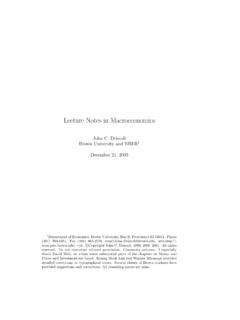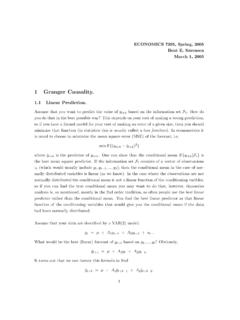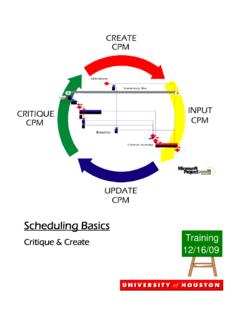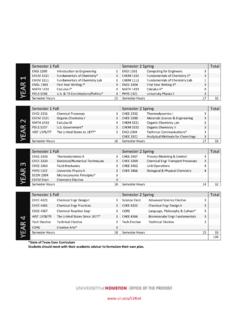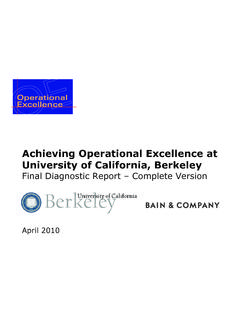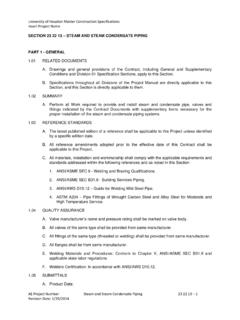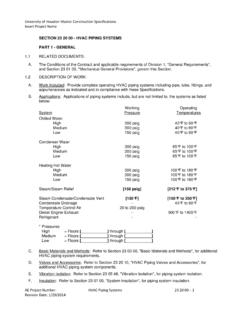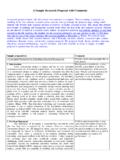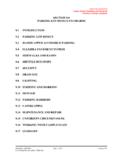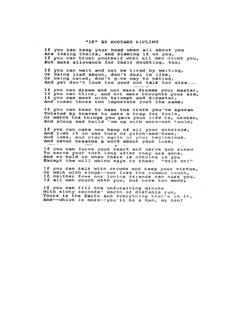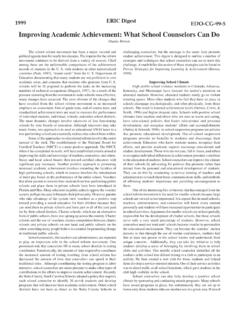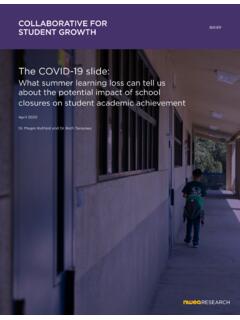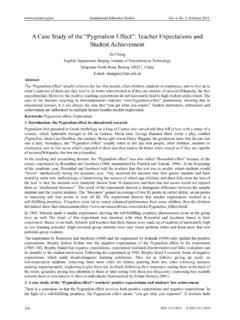Transcription of Dressed for Success: Do School Uniforms Improve Student ...
1 Dressed for success : Do SchoolUniforms Improve Student Behavior,Attendance, and achievement ?Elisabetta Gentile1 university of HoustonScott A. Imberman1 university of HoustonMarch 4, 2009 Abstract:Concerns about safety in urban schools has led many School districts to requireuniforms for their students. However, we know very little about what impact School uniformshave had on the educational environment. In this paper we use a unique dataset to assesshow uniform adoption affects Student achievement and behavior in a large urban schooldistrict int the southwest. Since each School in the district could decide independently aboutwhether or not to adopt Uniforms , we are able to use variation across schools and overtime to identify the effects of Uniforms . Using Student and School fixed-effects along withschool-specific linear time trends to address selection of students and schools into uniformadoption, we find that Uniforms had little impact on Student outcomes in elementary gradesbut provided modest improvements in language scores and attendance rates in middle andhigh School grades.
2 These effects appear to be concentrated in female McElhinney Hall. houston , TX 77204-5019. We gratefully acknowledge funding and support fromthe AEFA New Scholars Award. We would also like to thank Mykhailo Sitiuk for excellent research correspondence should be made to Scott Imberman at and 2009 byElisabetta Gentile and Scott Imberman. All rights IntroductionAs urban schools have become more difficult to manage, administrators have increasinglyturned to Uniforms as part of a strategy to maintain Student safety and control over 1996, the US Department of Education found that only three percent of schools requireduniforms. However, in 2000, a survey of 775 principals by the National Association ofElementary School Principals found that 21% of schools had uniform policies, though it didnot specify whether they were required.
3 Today, many large School districts have some schoolsthat require students to wear Uniforms . Most notably Philadelphia public schools requireall students to wear Uniforms while Long Beach, California and Dallas requires uniformsin pre-secondary grades. In addition, the nation s largest School district, New York City,requires Uniforms in elementary grades. Other large School districts, including Miami-Dade, houston , Chicago, and Boston, allow schools to require , the effects of these Uniforms on students is unclear. Proponents of uniformshave argued that they reduce victimization of students, allow administrators and facultyto differentiate students from trespassers, encourage positive attitudes in students, reducebad behavior, and Improve attendance. On the other hand, opponents argue that uniformsrestrict students rights and impose financial hardships on low-income families (Brunsmaand Rockquemore, 1998).
4 Despite the large growth in the use of Uniforms in public schools, there is very littleempirical research that has been done to assess their effectiveness. Only a handful of papershave tried to assess the effects of Uniforms on Student outcomes. this is despite the evidencethat there is a substantial correlation between discipline, which Uniforms would most likelyaffect, and and Rockquemore (1998)look at the differences between students who attendschools with Uniforms and those who attend those without Uniforms in a nationally repre-2 See Fergusson and Horwood (1995) Finn, Pannozo and Voelkl (1995), Gottfredson (1981), Hawkins(1997), Hawkins and Lishner (1987), Jensen (1976), Lynam, Moffitt and Stouthamer-Loeber (1993), Maquinand Loeber (1996), Rhodes and Reiss (1969), and Sliberberg and Sliberberg (1971)..1sentative sample of high- School students and find little difference in absenteeism, behaviorproblems, and substance abuse while Uniforms correlate negatively with test scores.
5 How-ever, this analysis suffers from some fundamental flaws. First of all, as pointed out by Bodine(2003), much of the Brunsma and Rockquemore results are based on Catholic schools andthus may not be reflective of Uniforms in public schools. Second, even if they had a largenumber of public School students in their sample, Brunsma and Rockquemore s results wouldstill be biased due to selection of students into schools with Uniforms and schools decidingto require Uniforms based on previous discipline problems. For example, parents may sendtheir children to schools with Uniforms in response to improved discipline. If these parentsrespond this way because they have misbehaving children, this would bias the uniform im-pact downwards. At the School level, the potential for selection may be even larger sinceschools and districts do not choose whether to require Uniforms randomly.
6 In fact, it is likelythat schools and districts that choose to require Uniforms already have a substantial problemwith Student behavior. Thus, on average, schools with Uniforms will have more behavioralproblems and lower test scores than schools without, before we account for the impact of uni-forms themselves on these outcomes. In this case, the results in Brunsma and Rockquefortwill again be biased downwards, and they will underestimate the impacts of Uniforms . Yeung(Forthcoming) looks at the effect of Uniforms on Student achievement in two national panelsof students. He finds little impact of Uniforms on math and reading scores. Nonetheless,while he improves upon Brunsma and Rockquefort s strategy through value-added modelingthere still remains substantial potential for bias if schools choose whether or not to requireuniforms based on Student characteristics or trends in Student (1996) uses a change in uniform policy in the Long Beach United School District(LBUSD) to identify the uniform impacts.
7 In 1994 LBUSD required all schools coveringgrades PreK through eight to adopt Student Uniforms . Thus, Stanley compares Student out-comes before and after the change in policy. However, her analysis is limited to a comparisonof means and she does not provide measures of precision for her than look directly at outcomes of students who wear Uniforms , Wade and Stafford(2003) study how Uniforms affect students perceptions of themselves and of their peers. Theyfind that students score lower on assessments of their self-worth in uniform schools. Thisleaves open the possibility that Uniforms can actually be detrimental to students by reducingtheir self-esteem although, since they look at a cross-section, the concerns about bias raisedabove remain. They also found that teachers believed that Uniforms reduced the presence unique paper is Evans, Kremer, and Ngatia (2008) who evaluate a randomlottery that gave Uniforms to students in Kenya.
8 They find improvements in attendanceand, preliminarily, test scores for students who receive Uniforms . While this suggests thatuniforms can be effective tools at improving Student outcomes, the context is very differentfrom the United States. In this case the authors do not evaluate a policy change of imposinguniforms, rather they measure the impact of providing Uniforms for free to students in schoolswhere they are already required. This reduces the cost of education for those students, whowould have had to purchase the Uniforms otherwise. Thus, they are not able to evaluate theeffect of a change in uniform sparseness and the identification problems of the prior literature thus leave us witha very unclear picture of how Uniforms affect Student outcomes. We seek to address thisgap in the literature in this paper by studying uniform adoption in a large urban schooldistrict in the southwest (LUSD-SW).
9 In the early 1990 s schools in LUSD-SW began torequire Uniforms . Each School was permitted to decide on its own whether or not and whento adopt Uniforms . Since our data covers time periods before and after uniform adoptionfor many schools we are able to utilize a combination of Student fixed-effects, School fixed-effects, and School -specific time trends to identify the effect of Uniforms on Student find that Uniforms appear to have little effect on test scores, attendance, or disciplinaryinfractions for elementary (grades 1 - 5) students. For middle and high School (grades6 - 12) students, we find improvement in language scores but not math or reading. We3also find improvements in attendance rates. These effects both primarily occur in femalestudents. Disciplinary infractions increase, but it is unclear whether this is due to theuniforms themselves, uniform violations, or increased enforcement.
10 Thus, overall it appearsthat Uniforms have a small but positive impact on Student outcomes in higher Uniforms in LUSD-SWLUSD has permitted its schools to require students to wear Uniforms since at least , only a handful of schools required Uniforms . However, as shown in Figure 1, uni-form adoption grew substantially over the following 13 years. Of schools that responded toour survey of uniform policies, which we describe in more detail below, only 10% requireduniforms in 1993. By 2006, 82% of these schools and 80% of students in these schools hadrequired vary considerably in how they define their Uniforms . Schools can require specificshirt colors and styles and pant styles. In 2008 almost all schools that required uniformsspecified between 1 and 3 colors for shirts, and casual or denim pants in khaki or navy schools also required polo style shirts.
